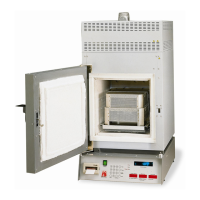
Do you have a question about the Thermo Scientific Thermolyne NCAT F85930-33 and is the answer not in the manual?
| Brand | Thermo Scientific |
|---|---|
| Model | Thermolyne NCAT F85930-33 |
| Category | Test Equipment |
| Language | English |
Explains warning symbols and their meanings for safety.
Lists safety warnings to avoid hazards like electrical shock and burns.
Details personal injury prevention and risks associated with refractory ceramic fibers.
Describes the tester's purpose for determining asphalt content by loss on ignition.
Explains the furnace heating, sample testing, and exhaust process.
Details operating and storage temperature and humidity requirements.
Visually inspect for damage, remove packing material, and clean chamber.
Remove balance and other components; prepare workspace and retain packaging.
Lists items included in the main furnace carton.
Lists items included in the accessory kit.
Guidelines for placing the furnace on a stable, level surface with adequate space.
Instructions for connecting the furnace to the power supply, including voltage and amperage.
Advice on connecting the exhaust system to ensure proper ventilation and prevent damage.
Steps for installing the electronic balance, including unpacking and placement.
How to access the printer, use its controls, and manage paper.
Tips for saving paper and installing new paper rolls.
Methods for storing thermal printer tapes to ensure long-term legibility.
Explains the function of the four main displays on the controller.
How to view and change controller settings like temperature and sample weight.
Outlines the steps for performing tests and changing calibration factors.
How to program the wake-up date and time for automatic preheating.
How the inactivity mode works to shut down the furnace if idle.
Procedure to interrupt or exit the timer mode.
Tips on sample preparation, including preheating and avoiding volatile solvents.
Advice on load capacity, splitting samples, and optimizing testing.
Table listing common problems, causes, diagnostics, and remedies for AC results.
Explains the equation and usage of the Bitumen Ratio for asphalt content.
How the software handles test interruptions and automatic shutdown.
How to use positive calibration factors and adjust stability thresholds for accurate results.
How to connect the furnace to a computer for data logging and transfer.
Details the format and meaning of data output from the serial port.
Lists and explains error codes related to the furnace operation.
Lists and explains error codes specific to the Setra balance.
Accessing diagnostics and resetting variables to factory defaults.
Adjusting temperatures and disabling error codes.
Performing chamber calibration and switching operational modes.
Instructions for element plate care and periodic chamber cleaning.
Step-by-step guides for replacing key components like elements and thermocouples.
Procedures for replacing or realigning door switches and locks.
List of replaceable parts with part numbers, descriptions, and voltages.
Continuation of the replacement parts list with more components.
Diagram showing exploded view of insulation and filter parts.
Diagram showing exploded view of heating elements and related parts.
How to request service, parts, and obtain RMA numbers.
Policy regarding product returns for repair or credit.
Schematic showing the electrical connections and layout of the furnace.
List of components referenced in the wiring diagrams with their part numbers.
Details on the default 27 Amp configuration for 240V units.
Instructions for changing the furnace from Low Amp (20A) to High Amp (27A) configuration.
Instructions for changing the furnace from High Amp (27A) to Low Amp (20A) configuration.
Definitions for terms like Balance Stability, Calibration Factor, EPROM, and Error Codes.
Definitions for terms like Idle Mode, Initialization, Lift Test, Program Mode, and Test Endpoint.